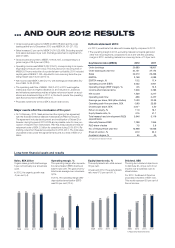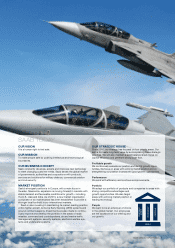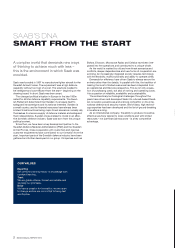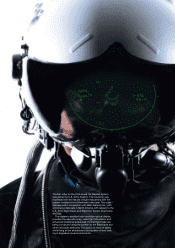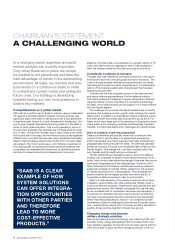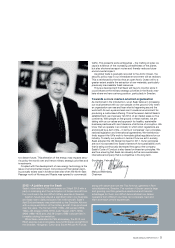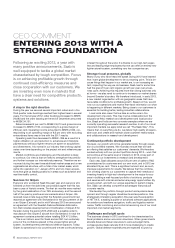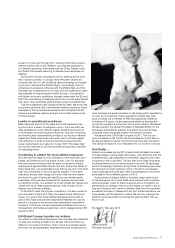Saab 2012 Annual Report Download - page 14
Download and view the complete annual report
Please find page 14 of the 2012 Saab annual report below. You can navigate through the pages in the report by either clicking on the pages listed below, or by using the keyword search tool below to find specific information within the annual report.10 SAAB ANNUAL REPORT 2012
MEGATRENDS
A RAPIDLY CHANGING WORLD
As the world changes, so do our defence
and security needs. Due to megatrends such
as globalisation, economic growth, popula-
tion growth, urbanisation and rapid techno-
logical development, we need to build on the
way we traditionally think about security. This
is true politically, militarily and economically
as well as nationally and internationally.
Global rebalancing – urbanisation, flow-related
and maritime issues
The ongoing emphasis shift of economic and political power from
the “Western world” to growth regions, chiey regions in Asia,
demonstrates the importance of economic factors now being
awarded more or less the same signicance as military power – at
least during peacetime.
New vulnerabilities and threat scenarios become evident as we
become more closely linked in an increasingly global context. The
need to safeguard and protect critical ows and hubs in society
also becomes more obvious. These include crucial infrastructure
and functions such as airports, ports, railways, motorways, trade
ows, mass transportation and energy systems. But the modern
concept of security is not merely a matter of protecting these
functions against direct threats and disasters, but also of facilitat-
ing functionality, efciency, sustainability and commercial aspects.
In light of the geographic and economic policy background, the
shift in emphasis towards the Asia-Pacic region makes the mari-
time dimension increasingly important. Military strategists and po-
litical decision-makers need to think increasingly in terms of seas
(territorial seas and sea-based ows) and less in terms of land.
The global governance aspect
The changes taking place in the world today give rise to plenty
of challenges and opportunities, as well as uncertainties. Over
time, global governance and regulatory systems can retain their
legitimacy and effectiveness only when they adapt to real-world
developments – e.g. regional differences in population and
economic growth. The strong emergence of new players with
new ambitions imposes new and different types of demands, and
potential conicts of interest emerge. This also alters the global
governance situation. Due to these trends – in combination with
multiple disputes about and differing views on the rules of the
game, standards and values – the issue of global power structures
becomes increasingly relevant. Are we now seeing a redistribution
of the global balance of power?
Trends, threats and opportunities going forward –
anew meaning of “security”
In order to adapt the concept of security to future conditions and
to retain a technological advantage, new aspects, threats, risks,
challenges and opportunities must be more clearly included.
New technologies
The technology factor is increasingly important for companies like
Saab. Developing and retaining a technological advantage will be
crucial in the competition in the defence and civil markets alike.
Also, defence and civil companies will increasingly compete for
contracts in each others’ traditional areas as the lines between
the military and civil are blurred and as technology plays a more
important role.
New stakeholders and players
With an expanded security concept, stakeholder groups will also
grow from the current nation states and government institutions
to increasingly include new stakeholders such as leaders of major
cities; global companies; network, transport, logictics and infra-
structure operators; and health care players.
Pressure from a growing global middle class is a strong driver
From a political and sociological perspective, economic growth,
easily accessible IC technology and the emergence of the con-
nected society have created a platform for a growing “global
middle class”. This trend is closely linked to the urbanisation trend
(which is stronger than population growth) in developing countries
and regions.
With demands for social welfare, freedom, justice and political
inuence, this is a growing challenge for politicians and their le-
gitimacy in many countries. The global middle class is generating
forces that seldom recognise geographical limitations.
Understanding the military sector
In a globalised, more afuent and enlightened world, traditional
war will in all likelihood be a less rational option. Statistics conrm
a long-term downward trend for armed conict, particularly in
terms of international conicts. In the long term, this trend will
impact military and security doctrines.
Running parallel with this trend is a rising need for modern
society to protect itself against a number of non-traditional,
non-military threats. These new security needs will not replace
traditional military scenarios. However, in many western countries,
defence spending is being impacted for government nances.
This is resulting in both restructuring reforms and an adjustment
of ambitions.
Anticipating the war of tomorrow
In a ve-year perspective, wars will by and large probably be
fought as they are today. But in the long term, the way in which
military powers plan and wage their conicts will very likely
change. As technological advances spread throughout the world,
threat scenarios will also change for most countries. In the not
too distant future, society will need to create the power to resist
and defend itself against, e.g. advanced, coordinated asymmetri-
cal threats from unmanned kinetic weapons in combination with
cyber attacks. These may also target social functions rather than
traditional military targets, and may be carried out by hard-to-
identify aggressors, planned and coordinated by other countries
or other players with considerable nancial resources.
Economics from a strategic security perspective
Economic security is no longer only a matter of safeguarding re-
sources such as food, water or other things that enable a country
to withstand a war. Economic security today is also a matter of
general economic growth and prosperity, which requires efcient
ows of goods, services and information. The economic dimen-
sion is given increasing importance in modern security doctrines.
The U.S. Defense Strategy Guidance from 2012 emphasised that


